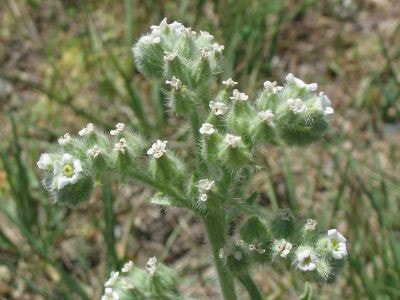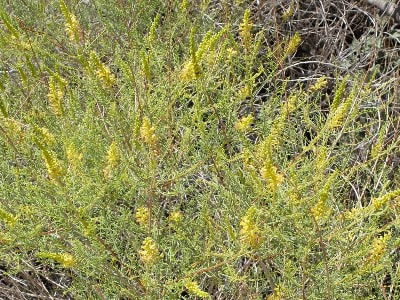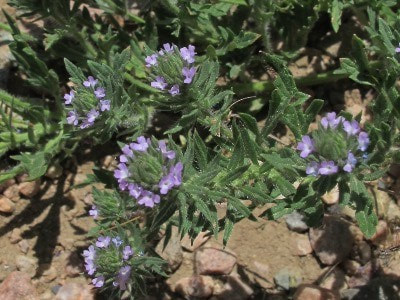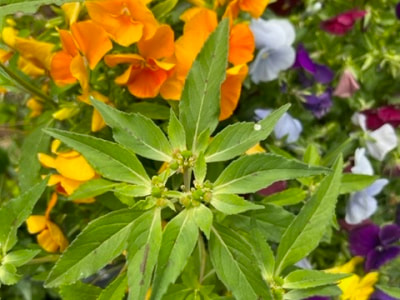|
Found in disturbed sandy, rocky areas, roadsides
Seen blooming in July in Arroyo Trujillo, Abiquiu Plants in the Cryptantha genus are commonly known as Catseyes. The whole plant is covered with rough silvery hairs. They produce nutlets that vary in size, shape and color and are used for identification. James’ Catseye blooms throughout the season growing to 12 inches high branching from the base. It has tiny flowers with five white petals and a yellow center. They grow in S-shaped clusters, like a scorpion tail, that elongates as it matures. It produces four shiny, smooth nutlets that are bow-shaped. Traditionally, the plant was given to newborn infants for prenatal snake or toad infection, a poultice of the plant was applied to snakebites and sores. It was also used ceremonially as a life medicine. Source. If you trying to identify a different flower then you can check what other flowers bloom this month. If you cannot identify a flower from the website, send a photo and where you took it to [email protected]. Read online for tips.
1 Comment
Found in sandy soils, sand dunes
Seen blooming in July in Arroyo Toro, Santa Fe NF, Medanales A strongly aromatic shrub growing over 3 feet tall with leaves divided into narrow, rolled leaflets. It has an overall broom-like appearance. Flowers grow in a long cluster lacking petals but with long, showy yellow stamens. Seed pods are small and yellowish with dark polka dots. It was used medicinally by the Hopi, Tewa and the Ramah Navajo as a toothache remedy. It was also used for basketry and kachina masks. Roots were made into hooks and used to secure packs on burros during salt expeditions. Source. If you trying to identify a different flower then you can check what other flowers bloom this month. If you cannot identify a flower from the website, send a photo and where you took it to [email protected]. Read online for tips. Bracted Vervain, Bigbract Verbena, Carpet Vervain,Verbena bracteate,Verbena Family (Verbenaceae)7/8/2022 Found in sandy, gravelly soils, disturbed areas
Seen blooming in July at Okhay Owingeh Airport Bracted Vervain has creeping, hairy stems growing to 18 inches long and hairy, lobed leaves. Tiny light blue to purplish flowers grow in whorls at the end of the stems and have stiff, hairy bracts. The five petals are fused at the base forming a slender tube. As the flowers mature the stem elongates up to 6 inches with flowers blooming at the tip and fruits forming below. Traditionally, the Navajo applied a poultice of the plant to centipede bites, and the plant was used in ceremonial chant lotion. Source. The Lakota used an infusion of the root to treat tuberculosis, particularly when it had spread to the lymph nodes. If you trying to identify a different flower then you can check what other flowers bloom this month. If you cannot identify a flower from the website, send a photo and where you took it to [email protected]. Read online for tips. Found in sandy, disturbed areas, roadsides
Seen blooming in late June in a pot of pansies in Abiquiu Photo credit: Carol Bondy Wild Poinsettia grows to two feet high with inconspicuous whitish flowers and lance-shaped, toothed leaves, The leaves are often red-splotched and whitish at the base. Its structure resembles the red holiday poinsettia to which it is closely related. The plant produces a poisonous milky sap when broken that can cause contact dermatitis and is harmful to eyes. Nonetheless, the plant was eaten by Keres mothers to produce more milk. Source. If you trying to identify a different flower then you can check what other flowers bloom this month. If you cannot identify a flower from the website, send a photo and where you took it to [email protected]. Read online for tips. Found in moist areas, seeps, stream banks
Seen blooming in June near the Rio Chama in Abiquiu You need a sharp eye to spot this delicate, star-shaped flower blooming in the grass. Blue-eyed Grass is not really a grass at all, but a type of Iris. It grows up to 20 inches tall with flat grass-like leaves and branched flower stems. Flowers are barely ½ inch across. They are bluish-violet with a yellow eye at the center and a bristle at the tip of the petals. Sisyrinchium species have a long history of medicinal use. They were used by Native Americans to ease hay fever, encourage regular bowel movements, quell diarrhea and to treat intestinal worms and stomach ache. Source. If you trying to identify a different flower then you can check what other flowers bloom this month. If you cannot identify a flower from the website, send a photo and where you took it to [email protected]. Read online for tips. |
AuthorI am Marilyn Phillips, a native of England, whose love of nature and the outdoors from childhood brought me by a circuitous route to Crested Butte, Colorado in 1993 and 16 years later to northern New Mexico. My exploration of the many trails in these areas, my interest in wildflowers and photography, and career in computer system design came together in this creation. If you have any corrections, comments or questions, please contact me by email. Archives
September 2025
Categoriescopyright © 2020
|







 RSS Feed
RSS Feed